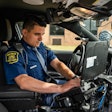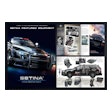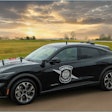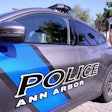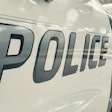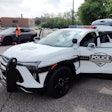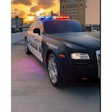The motorcycle police officer has been an American icon for more than half a century. As envisioned by the public, he is a hybrid of a cowboy and a knight, dressed in black leather, carrying a six-gun (.38) on his hip, and astride a monstrous Harley-Davidson. It's little wonder that "motor" officer is one of the most coveted jobs in many police agencies. But contrary to "CHiPs" fantasies, the job is not all glamour, and working a police shift on two wheels is just as tough, if not tougher, than working the same shift in a patrol car.
Like their car-driving compatriots, motorcycle officers handle many tasks. Yes, their primary duty is traffic enforcement, but there's more to working a bike than making traffic stops and issuing citations. Motor officers get the call for parade and funeral details, emergency response when bikes can reach the scene faster than cars, and even public relations campaigns.
Motorcycles offer many advantages for police operations. They can go places full-size four-wheelers can't; they can slice through gridlocked traffic with ease; and they can accelerate past most high-performance cars on the market. But motorcycles have their disadvantages as well. You simply can't load as much stuff onto and into one as you might a patrol car; they can't be used for prisoner transport; they can be frightfully uncomfortable after a few hours of a traffic shift; and they offer their drivers little or no protection in an accident.
After weighing the pros and cons of motorcycles on the job, many agencies choose to field bikes. The question is which bikes to field and why.
There are currently three motorcycle manufacturers that dominate the American police market: BMW, Harley-Davidson, and Kawasaki. And if you ask motor officers about their favorite bike brands, you'll get the same kinds of near-dogmatic opinions that you'd get asking NASCAR fans about the relative merits of Fords and Chevys on race day. It's an interesting discussion, but nobody will ever change his or her opinion.
Instead of surveying brand preferences, POLICE sought out motor officers and motorcycle fleet managers to ask them what they like or dislike about certain makes and models, and, more importantly, what modifications and new features would they like to see on their mounts.
Good and Bad
So what sort of wish list do motor officers secretly pen in their off-duty hours? What sorts of features do they think would improve their bikes and, thus, their own job performance?
To answer these questions, we contacted motor officers across the nation. A typical agency was the Simi Valley (Calif.) Police Department. Located just north and east of Los Angeles, Simi Valley is a growing community with an active police force that includes a strong motor unit.
The Simi Valley PD is also typical because it fields a collection of new and old bikes from several manufacturers, including BMW R 1150 RT-Ps and Kawasaki Police 1000s. Consequently, Simi Valley motor officers and motor fleet managers can speak authoritatively about the strengths and weaknesses of these machines.
From a maintenance standpoint, Simi Valley officers say the BMW Boxer twin engine has a service interval nearly twice as long as the Kawasaki's inline four. This, combined with the fact that the BMW's tires are readily available, tubeless, low-profile, 17-inch radials commonly found on contemporary sport or sport-touring bikes, scores points for the German-made bikes from the Simi fleet managers. However, officers who ride the bikes are more concerned with safety and performance than maintenance costs, and they point out that the Kawasaki's narrow 18-inch tires, while more expensive than the BMW's 17-inch radials, offer run-flat capability.
And in some cases, you have to take the good with the bad when it comes to motorcycle engineering. For example, BMW's shaft final drive means no chains and sprockets to replace, but the shaft isn't as durable under some of the more demanding, out-of-the-ordinary stresses of police work.[PAGEBREAK]
Street policing demands also tend to tax the BMW's single-plate, dry clutch, compared to the multi-plate, oil-bathed clutch that Kawasakis and Harleys use. "It is an adjustment; it's a learning curve to figure [the BMW] clutch out," Simi Valley PD Officer Patrick Coulter admits. "But in this environment-in a metropolitan police department where you're jumping curbs and doing the silly stuff that a CHP officer more than likely does not do on a daily basis-I would like to see a wet clutch or a multi-plate clutch."
Rich Greenwood, who retired from the Los Angeles Police Department after a career that saw him on motors for 19 years, believes that the clutch design is one of the reasons why the BMW police models offer great advantages for highway officers, but are not necessarily well adapted to urban policing. "[BMWs are] nice bikes, but they're better suited for the freeways; they aren't real good for slow riding, and we do a lot of slow riding [as city cops]."
However, the BMW's electrical system is well-suited to urban policing. With all the electronic instruments and accessories on modern police vehicles, the BMW's dual battery system received high marks from motor officers. "The load requirements of our job with the radio and all the electronics and the radar systems that are mounted on the bikes just require an incredible amount of amperage that a regular civilian bike doesn't need," Simi Valley PD Officer Dan Hampson points out.
"When you throw that load onto just a one-battery system like the Kawasakis have, we just go through batteries left and right. If you're home on your weekend and you forget to turn off the radio, your battery's toast when you go to start it two days later, and it won't come back-you've got to replace it," Hampson adds.
A Place for Stuff
Simi Valley officer Coulter singles out a common complaint about all police motors: lack of storage space. "We have such limited storage for the amount of stuff we need to carry that if we can just put it in the saddlebag and forget it, and have the things we go to every minute right there on the outside of the bike, that's what we wish the manufacturers would do," he says.
To remedy this problem, Simi Valley PD fabricated a citation book holder that mounts behind a crash bar on one side of the bike. But manufacturers are also starting to listen to cops about their needs for better storage options. A combination rechargeable flashlight/baton holder is a much-appreciated accessory on the Harley-Davidson FLHPI Road King in use at the Peabody (Mass.) PD traffic unit, according to Sgt. Bill Cook.
"Kawasaki and BMW also do a great job of manufacturing the crash rails that provide points to mount [accessories] on," Coulter observes. The Kawasakis have good points and BMWs have good points to mount [accessories] on."
Tailored Fit
For all motorcyclists, it's critical to adjust the bike to match the size of the rider. For motor officers, fitting is even more important because the machine happens to be the "office" where they spend most of their day. One size fits all doesn't cut it.
BMW's three-step seat height adjustability gets credit in this area. Though you can't quickly and easily move the handlebar or adjust the angle of the levers on the BMW as you can on the Kawasaki 1000 Police, you can easily adjust the distance from handlebar to lever on the BMW R 1150 RT-P. (Note: Late-model Kawasaki sport bike levers are adjustable and might be able to be adapted to the Police 1000.)[PAGEBREAK]
For overall comfort, the Simi officers give the nod to the BMW. The German machine places the rider in a more forward cant with the feet farther back, almost underneath the hips so jolts don't get transferred straight up the spine. "It is a very easy shift on a BMW," Coulter says. And Hampson adds enthusiastically, "Riding a BMW is more comfortable than sitting in a car."
Harley's FLHPI Road King also gets high praise for comfort from Officer Bob Cronin who's been on motors for 13 years at the Andover (Mass.) Police Department. The bike's comfort features include an air-assist saddle that allows the rider to easily adjust riding height and peddle reach.
Unfortunately for Cronin, riding a bike year-round in Massachusetts involves more comfort issues than just seat adjustment. When winter comes, he wishes his Harley had the heated grips that are standard on BMWs. Also at 6-foot, 2-inches, Cronin runs the air-assist solo saddle virtually at zero pressure so as not to place his head above the windshield. As a result, staying warm on duty deprives him of some of the benefits of the air adjustability in the seating system.
Speed and Power
Most motorcycle enthusiasts want more power, and that's also true of motor officers, but that's not a complaint that they have about any of the popular police bikes currently in use at their agencies.
And interestingly enough, most motor officers love engine power not just because it translates into more speed for pursuit. Bill Fullmer, a former California Highway Patrol motor officer who spent two years on Kawasakis, explains: "We do protective service and stuff where if the president comes in, you escort [the motorcade] and you have to be able to go real fast. We have to accelerate fast so we can get around what the Secret Service calls 'the package,' the presidential package, and stop lanes [farther up the road] again; you go up to [the next] intersection for him-kind of leap-frog. It's the closest thing to racing that I ever got to do in the Highway Patrol."
Slowing Down
On the other end of the spectrum, when it comes time to decelerate, the BMW's more modern calipers and floating rotors coupled with its partially integrated ABS represent the state of the art for police use. In a partially integrated system, applying the front brake fully activates both front calipers and partially activates the rear; applying the rear brake activates only the rear, giving experienced riders great maneuverability.
On the other hand, long-time Harley-mounted officers and experienced riders like Cronin don't see ABS as an absolute must-have, though even he admits, "It'd be nice to have in an emergency situation when you've got to clamp down [on the brakes] and don't want the wheels to skid. It's one less thing to worry about."
Due to its shaft drive and engine layout (opposed twin), the BMW does exhibit noticeable "torquing" or rocking when you get on the throttle, whether at a stop light or when exiting a turn. Kawasakis-as well as Harleys-don't have this trait, thus behaving "normally." Harley's belt drive has proven to be a decent compromise, combining the low maintenance and quiet running of a shaft with the strength and simplicity of a chain.
Getting It in Gear
None of the motor officers interviewed for this article expressed a desire for their agencies to field bikes with automatic transmissions, either of the continuously variable ratio type or automotive style. That may be due to the fact that there are currently no widely popular consumer models with an auto.
However, automatic transmissions may be the wave of the future for police motorcycles and consumer bikes. Autos are being developed in more and more of the popular ATVs, and auto transmission-equipped Honda 650 Rincons finished first and third in the ATV class at the 2002 Baja 1000.
Industry experts say manufacturers will soon be ready to produce a police motorcycle where the rider doesn't have to worry about gear selection with a transmission that is rugged enough for duty use.
Though not an all-encompassing, rigidly scientific tally of the entire population of motor officers across the country, what we discovered while researching this story was that, for the most part, officers are satisfied with their bikes. This indicates that the manufacturers have provided good police bikes.
Yet, as in most things in the vehicle world, there are a number of things that could be done to these basic models to "dial them in" and make them even better platforms, custom-tailored to their officers, the locations where they serve, and the expected rigors of their duty.
Motor officers should let the industry know what adjustments and accessories they want for their bikes. If demand is high enough, there's always a chance that these features could become readily available through the manufacturers or through aftermarket vendors.









